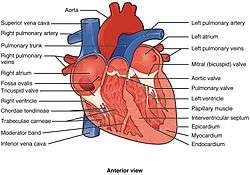Trabeculae carneae
The trabeculae carneae (columnae carneae, or meaty ridges), are rounded or irregular muscular columns which project from the inner surface of the right and left ventricle of the heart.[1] These are different from the pectinate muscles, which are present in the atria of the heart.
| Trabeculae carneae | |
|---|---|
 | |
| Details | |
| Identifiers | |
| Latin | trabeculae carneae cordis |
| TA | A12.1.00.020 A12.1.02.021 A12.1.04.011 |
| FMA | 76525 |
| Anatomical terminology | |
Types
There are 2 kinds:
- Some are attached along their entire length on one side and merely form prominent ridges,
- Others are fixed at their extremities but free in the middle, as in the moderator band in the right ventricle, or the papillary muscles that holds chordae tendinae, which are connected to cusps of valves to control flow of blood into the heart
Function
The purpose of the trabeculae carneae is most likely to prevent suction that would occur with a flat surfaced membrane and thus impair the heart's ability to pump efficiently.
The trabeculae carneae also serve a function similar to that of papillary muscles in that their contraction pulls on the chordae tendineae, preventing inversion of the mitral (bicuspid) and tricuspid valves towards the atrial chambers, which would lead to subsequent leakage of the blood into the atria. By this action on the atrioventricular valves, backflow of the blood from the ventricles into the atria is prevented.
The moderator bands carry the right branch of the bundle of His and are part of the conducting system of the heart.
See also
References
This article incorporates text in the public domain from page 532 of the 20th edition of Gray's Anatomy (1918)
- Moore, K.L., & Agur, A.M. (2007). Essential Clinical Anatomy: Third Edition. Baltimore: Lippincott Williams & Wilkins. 90-94. ISBN 978-0-7817-6274-8
External links
- thoraxlesson4 at The Anatomy Lesson by Wesley Norman (Georgetown University) (heartinternalstructures - "TC" on diagram)
- Diagram at University of Edinburgh—fourth and fifth diagrams from top